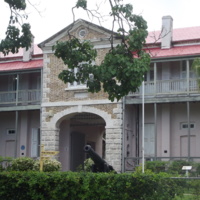
Barbados Museum and Historical Society
The Barbados Museum and Historical Society was founded in 1933. It is a not-for-profit, non-governmental organisation which aims to collect, preserve and interpret Barbadian heritage for its communities. Housed in a former prison, the museum now holds a collection of around half a million objects, dating from prehistory to today, as well as a significant archive.
The museum's permanent galleries explore the history of Barbados and its people through a range of different themes, including social, natural and military history. Colonialism and slavery feature as key themes in several of these galleries. In the Jubilee Gallery, which contains items relating to social history, the exhibition narrative charts four thousand years of Barbadian history. This includes the development of Barbados into a plantation society, life for the enslaved on those plantations and their lives post-emancipation. The Charles A. Robertson African Gallery also reflects on the legacies of slavery with regards to the African diaspora and its heritage within the Caribbean. Here the focus is on the processes of the slave trade, particularly the forced movement of people to the island. Objects in this exhibition reflect different African kingdoms, traditional customs and the diversity of African people.
In addition to its permanent exhibitions the museum also offers a range of learning opportunities relating to the history of slavery in the area. From educational island tours, to school visits and a programme of public events, the museum caters for a wide range of audiences.
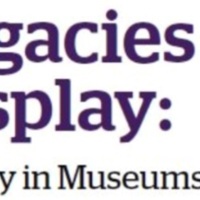
Hanover Museum
The Hanover Museum dates back to the eighteenth century, and is housed in a former slave prison. It was redeveloped in 2011 and now stands as an important symbol of resistance to the people of Jamaica. Situated in the small town of Lucea, between Montego Bay and Negril, the museum sits within a wider landscape of Georgian colonial architecture. Other buildings of historical significance include the nearby church and Fort Charlotte.
The museum houses a varied collection charting the development of the town from the period of plantation slavery to Jamaican independence from British rule. There are paintings, pottery and other artefacts that showcase what life was like for the enslaved. There are also instruments, including stocks, whips and shackles, that highlight the brutal nature of enslavement. In addition, the museum houses a significant collection of archival material, including plantation records and accounts, as well as an early, hand-drawn map of the harbour and surrounding area by Captain William Bligh.
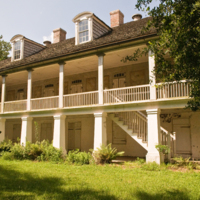
The Whitney Plantation
Widely claimed to be the first museum in America to solely address slavery, the Whitney Plantation is a plantation estate, museum and memorial outside New Orleans, on Louisiana's famed River Road. During the eighteenth and nineteenth centuries, the plantation was home to the Haydel family, and their enslaved workers. The site was bought in 2000 by a retired lawyer, John Cummings, who funded the renovation and redevelopment of the site, which opened to the public as a museum in 2014. On arrival, visitors must join a guided tour to see the majority of the site, but the museum is open to all.
On the property visitors will find a range of exhibits, including the Mansion House, slave quarters, a blacksmith's shop and a Baptist church. There is also a 'Wall of Honour' which features the names of all those enslaved at the plantation, as taken from the site's archives. In addition, there is a sculpture installation created by American artist Woodrow Nash called 'The Children of Whitney,' that seeks to remind visitors that slavery affected children as well as adults.
The site houses a significant collection of artefacts too. These range from plantation tools and house furniture. There is even the largest collection of sugar kettles in the whole of Louisiana. Much of this collection has been purchased at auctions around the USA, in a bid to redisplay the site as it was during the antebellum period. There are three archaeological sites which also contribute collections of material linked to the lives of the enslaved themselves. All of this provides visitors with a unique perspective of plantation life, and helps to break down the ignorance still surrounding histories of American enslavement.
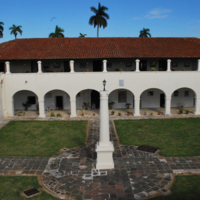
Museo Nacional Ruta del Esclavo
The Museo Nacional Ruta del Esclavo (Slave Route National Museum) is housed in San Severino Castle, in the Matanzas district of Cuba. It opened in 2009, as the product of UNESCO's Slave Route project. Off the beaten tourist track, the museum in the seventeenth-century castle receives few visitors.
The museum itself houses an important exhibition, aimed at showcasing the horrors of the Transatlantic Slave Trade in order to prevent the like ever happening again. The museum has four exhibition rooms with photographs, objects and archaeological items accompanied by interpretive text. These rooms address the origins of slavery, the plantation systems, abolition and emancipation, and the ongoing legacies affecting people of African heritage around the world.
After being selected by UNESCO to house interpretation for the Slave Route project, the museum has supported a number of African cultural groups in the local area, as well as hosting activities for the nearby university. In the exhibition space itself, there are fourteen African sculptures donated by Cuban artist Lorenzo Padilla.
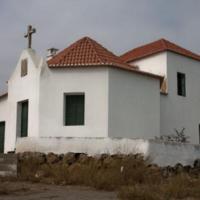
National Museum of Slavery
The Angolan National Museum of Slavery (or Museu Nacional da Escravatura in Portugese) was founded by the National Institute of Cultural Patrimony in 1997. Its main aim is to depict the history of slavery in Angola. The museum is situated in a chapel which once belonged to Álvaro de Carvalho Matoso, one of the largest Portugese slave-traders in the eighteenth century. It is also next door to Capela da Casa Grande, a seventeenth-century structure which was once used for baptising enslaved Africans before they were shipped to the Americas. The museum has a large collection of items that were utilised in the slave trade, as well as items relating to African culture pre- and post- transatlantic slave trade and a vast photography collection. Situated 15.5 miles outside the city of Luanda, the museum forms an extraordinary landmark along the "Slave's Route."
While the museum itself is realtively modest, it's aim is a big one; 'it is a testament and a reminder of the history of the Angolan people who lived in the day of slavery and it stands as a monument to those who suffered and were affected by slavery.' The narrative in the museum focusses predominantly on Portugal, the main European slave trader in the Angola region. It provides a contextual history of the Atlantic Slave Trade, as well as highlighting slavery in Africa before the involvement of Europeans.
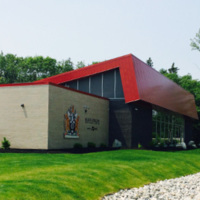
Black Loyalist Heritage Centre
The Black Loyalist Heritage Centre interprets the story of the world’s largest free African population outside of Africa in the late eighteenth century in Nova Scotia. Set in two acres of grounds, the centre combines purpose-built archives and conference facilities with historic buildings and the National Monument commemorating the Black Loyalist Landing in Birchtown in 1783. The centre was funded by both government and private donations and opened in 2015.
The centre houses a multimedia presentation of the Black Loyalists' journeys from Africa to the American colonies, then to Nova Scotia and back again. In addition, there is an archive where visitors can trace their own ancestors, a virtual version of Carlton's 'Book of Negroes' that visitors can browse, and an opportunity to create a virtual quilt square reflecting on the visitor experience.
As well as these technological initiatives, there is also a pit featuring archaeological remains excavated from Birchtown in the 1990s. With these collections, the museum showcases both the significance of the African presence in Nova Scotia, as well as the African Diaspora around the world.
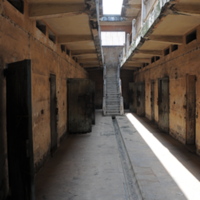
Ussher Fort Museum
The museum is housed within Ussher Fort, one of three European forts built in the Accra region of Ghana during the mid-seventeenth century. Developed by Ghana's Ministry of Tourism, with support and funding from UNESCO, the museum opened in 2007.
The museum aims to highlight the history of the transatlantic slave trade in Ghana. Beginning with the development of the trade in human beings, the museum covers the history through to British abolition.
The collection is varied and includes items once used by both captors and victims. There are weapons, African household items and a model of a slave vessel. The museum also contains paintings of several key abolition figures, including William Wilberforce and Harriet Tubman.
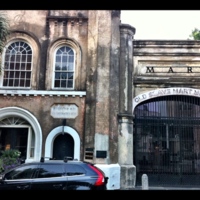
Old Slave Mart Museum
The first African-American Museum, the Old Slave Mart Museum has been open sporadically since 1938. Located in Charleston, South Carolina, it was built in 1859. It is thought to have been the last surviving slave auction gallery in South Carolina. It was used briefly before the American Civil War ended slavery in the American South.
The building itself is living history, and inside there are displays attesting to what happened there, as well as providing wider context about American slavery and its lasting legacies. The collections are quite sparse in terms of objects from the slave trade but there are many photographs.
The museum makes use of personal testimonies to bring the history to life through the voices of the enslaved and their descendants. These are presented as audio clips, available for visitors to sit and listen to. The interpretation features many examples of statistics, as well as maps and contemporary images.
All of the above forward the museum's mission to broaden public understanding of Charleston as a slave-trading centre in order to reach out to the local community.
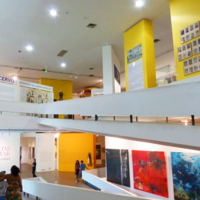
Museu Afro Brasil
First opened in 2004, the Museu Afro Brasil is a contemporary museum which seeks to showcase the contributions of black communities to Brazil and its culture. There are over six thousand objects in the collection, including paintings, sculpture, photographs, ceramics and textiles. Through all of these items the museum illustrates the creative nature of Brazilian people. The exhibitions grew from the private collection of visual artist Emanoel Araujo who has led the museum as Director since its opening. The site also houses a theatre and a specialised library.
In its permanent exhibition space, which displays around seventy percent of its collections, the Museu Afro Brasil emphasises the rich culture of the African continent from the fifteenth century through to today. There are a variety of art mediums and artefacts on display, including masks, sculpture, jewellery and archival material.
These objects link to social themes, such as celebrations and religions, amongst communities of African descent in Brazil. There is also a section that explores the memory of key figures in the Afro-Brazilian community. Another explores the work done by these communities. Historically, this area examines the work done when many African people in Brazil were enslaved. The display features a model sugar mill, different kinds of tools for use on plantations, and sugar loaf moulds.
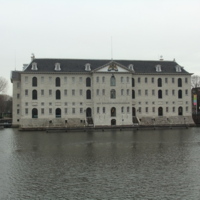
Het Scheepvaartmuseum
Het Scheepvaartmuseum is the National Maritime Museum of the Netherlands. Housed in a seventeenth-century naval storehouse, the museum showcases the ways in which Dutch culture has been influenced by the sea. A vast array of collections, including paintings, maps, maritime instruments and weapons illustrate these stories. Just outside the museum, there is a replica of an eighteenth century ship, the Amsterdam, which once sailed between the Netherlands and the Dutch East Indies. With fifteen permanent exhibitions and a free audio tour, the museum's four million annual visitors are exposed to over five hundred years of both Dutch, and world, history.
Dutch involvement in slave trading is highlighted in the 'See you in the Golden Age' exhibition. The interpretation here focusses on the seventeenth century, a time when the Netherlands was one of the most economically and culturally rich countries in the world. While the exhibition reflects this boom period through a variety of collections, it also illustrates the darker side of Dutch prosperity. By making use of contemporary narratives, the museum provides its visitors a chance 'meet' historical characters including Amimba, a young African girl who was forced into slavery.
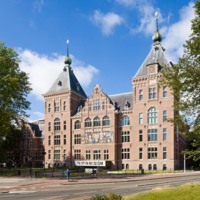
Tropenmuseum of World Cultures
The Tropenmuseum of World Cultures (direct translation; Museum of the Tropics) is an ethnographic museum, founded in 1864. Housed in one of the 'most impressive buildings in Amsterdam', the museum features eight permanent exhibitions and a series of temporary exhibitions. The key theme of the museum is people, with all of the exhibitions making use of the museum's vast collections of over 150,000 objects, paintings and photographs, to showcase universal human themes, including celebration, mourning and conflict.
In the 'Afterlives of Slavery' exhibition, visitors are confronted with the legacies of slavery and colonialism in contemporary Dutch society. Developed in collaboration with scientists, artists and activists, the exhibition tells the history of slavery with the experiences of the enslaved, and their descendants, at its heart. Video portraits provide the perspectives of four key figures in the contemporary debates about colonial legacies for Dutch black people.
The key link between past and present here is the continuation of inequality and prejudice. Collections, both historic and contemporary, highlight this, as well as illustrating how times have changed. These include testamonies of enslaved people, books, portraits, 'relics of slavery' and examples of African art.
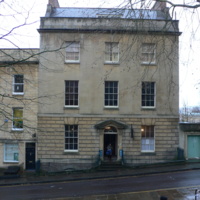
The Georgian House
The Georgian House was built in around 1790 for a plantation owner and sugar merchant named John Pinney (1740-1818), who settled in Bristol when he left Nevis. Two black servants, one bought as a child, the other born on Pinney’s Nevis plantation, also lived and worked in the house: Pero Jones (c.1753-1793) and Fanny Coker (1767-1820). Fanny had been given her freedom at the age of 11, Pero remained enslaved.
The House was presented to the city in 1937 and Bristol City Council has operated the site as a period-house museum since 1939. Rooms are open to visitors across four floors, and it is divided into life above and below stairs. Life above stairs features rooms such as the Dining Room and Drawing Room across the upper three floors, while life below stairs has the kitchen and housekeeper’s rooms in the basement. Information cards provide details about the objects within the rooms including furniture and paintings, and some information on the people who lived there. It is located in central Bristol near the University and Cathedral.
On the second floor there is a small 2D exhibition, in a room next to the bedroom, giving information on the family, the Nevis plantations, and the black servants. Panels have been present in the room since the 1990s, but they were updated and re-installed in April 2018. A large board features the names of the known enslaved people on the Pinney plantations over 200 odd years, and a graphics panel covers nine topics including Bristol and Slavery, John Pinney, Pero Jones, Fanny Coker, Hard Labour and Resistance. They connect the site, and city, to Transatlantic Slavery, through the stories of individual people.
In addition to this display there are implicit and explicit references to slavery throughout the house. Slavery is included on the introductory board and first information card on John Pinney. There are also objects, particularly downstairs, including a sugar cone in the larder and a newspaper discussing the slave trade on the kitchen table. Further audio and information is planned to be added at the house, which will tell more about the slavery connections of the family and house.
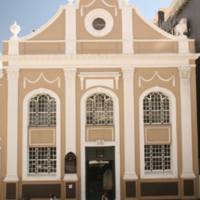
Sendinggestig
The Sendinggestig opened in 1977, situated in an old mission church which still functions for ceremonial purposes though lost its congregation – which mainly comprised poorer black and coloured people – when the terms of the Group Areas Act were applied to inner city spaces. The museum is colloquially referred to as the ‘Slave Church’, reflecting the presence of enslaved people in its original congregation founded in 1804. It is one of 28 museums affiliated with the Western Cape Provincial Government’s Museum Service. As well as providing funding, the Museum Service offers technical support in developing exhibitions. The Sendinggestig was originally conceived as a mission museum, and updated displays installed by the Museum Service in 2011 reflect this focus.
The displays installed in 2011 move beyond Eurocentric interpretations of history to offer a more inclusive history of mission activity and religious freedoms in the Cape Town area. Reference, for example, is made to the connections between slavery and the development of Islam in South Africa. In offering the building space to outside groups and performers, the museum also works to provide opportunities for alternative interpretation. This includes groups who identify with enslaved and Khoisan people as ancestors, and seek to reimagine their lives through song, poetry, and dance. A regular series of public events are held and attract sizeable audiences, whilst 1 December Emancipation Day is marked annually.
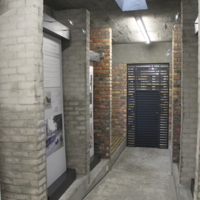
Prestwich Memorial
The Prestwich Memorial opened in 2008 as an attempt at resolving a protracted and sometimes unsavoury dispute sparked in 2003 when a property developer discovered human remains in central Cape Town whilst digging the foundations for an apartment complex. These remains were likely those of the colonial working classes, buried in the many unmarked eighteenth and nineteenth century graves. For certain activists, the remains were identified as those of their enslaved ancestors. A dispute began between people opposing exhumation on the grounds of respect for ancestors, versus those who advocated exhumation owing to the unprecedented opportunities offered to furthering historical and scientific knowledge. Following a public consultation process, the bones were exhumed, but were not subjected to analysis.
The memorial was constructed on behalf of the City of Cape Town municipality to house the remains, and provide an exhibition space to explain the affair. The opening of an artisan coffee shop named Truth in the memorial building in 2010 however created further contestations on the grounds of taste and respect for the dead.
The memorial features a number of fixed interpretation boards which explain the colonial burial system, the unmarked cemeteries beneath the modern city, and the type of people likely to have been buried in them. Enslaved people, of course, feature in this number. The bones themselves are situated in an ossuary area, accessible by a low entrance. They are separated from the public by a wooden gate. Whilst research applications to study the bones are invited, no applications have been accepted at the time of writing by a panel including stakeholders from various sides of the exhumation debate.
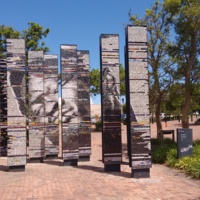
Spier
Spier is a wine estate, situated east of Cape Town close to Stellenbosch. It was founded in 1692 and, as with the majority of South African wine farms of a similar age, its early labour force rested on enslavement. Spier was one of the first wine farms to develop itself as a tourist attraction during the 1960s and 1970s, reflecting a shift in the Winelands economy from just the production of wine. Presently, Spier offers visitors a number of restaurants, wine tasting, conferencing facilities, accommodation, a market, and a variety of estate tours including by Segway. Historical features have been preserved and form part of these tours.
Spier is quite open about its past involvement in slavery. The 1825 slave bell has been restored and is highlighted on the audio tour of the estate. In 2012, an art piece named ‘The Dying Slave’ was designed by the South African artist Marco Cianfanelli and installed at the base of the hotel car park at Spier. This large and imposing structure consists of nine columns which, when the viewer stands at a distance, combine to produce an image which was inspired by Michelangelo’s image of a ‘Dying Slave’.
More obvious local connections with slavery are evident in the ‘Gables' audio tour launched in 2012. This is narrated by a fictional enslaved woman named Sannie de Goede and set in 1836 on the eve of the ending of the apprenticeship period. Using the smartphone app VoiceMap, the narrator guides the visitor around the estate, drawing attention to historical features from the perspective of someone who was forced to work on the estate. Written by playwright Brett Bailey, it should be viewed as part of a genre of historical fiction including works such as Yvette Christianse’s Unconfessed which seek to fill gaps in the colonial archive by reimaging the voices of enslaved women.
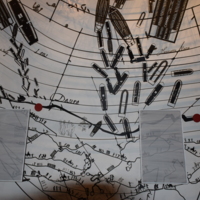
Freedom Park
Freedom Park opened in 2006 having been established as a Legacy Project of South Africa’s second democratically-elected president, Thabo Mbeki. Nine sites were established as Legacy Projects, receiving ample state funding as spaces considered priority sites in preserving national history. Freedom Park was conceived as a national memorial, with a central feature being the 'Wall of Names'; a memorial wall displaying the names of people associated with eight ‘struggle’ epochs which the site considers to define South African history. Elsewhere, evidence of the influence of Mbeki’s ‘African renaissance’ philosophy is prominent. Memorial features in the ‘Isivivane’ area include a symbolic burial ground titled ‘Lesaka’, and ‘Lekgotla’, an African meeting place surrounding the trunk of a uMlahlankosi tree.
A museum, named //hapo (‘dream’ in Khoi) opened in 2013, introducing explicitly didactic content to Freedom Park for the first time. Much like the ‘Wall of Names’, this is grouped into eight ‘struggle’ epochs. It weaves an Africanist narrative beginning by positing the continent as the cradle of mankind, and ending by suggesting that Africans can look to the past to solve the problems of the present, many of which it links with European colonisation. Freedom Park operates a substantial educational and visitor tour programme.
Freedom Park is the only museum in South Africa outside the former slave trading epicentre which is now the Western Cape to cover slavery in any detail. Slavery features as an epoch on both the ‘Wall of Names’ and in //hapo. With the former, it is not clear whether the names displayed are actually those of people enslaved in South Africa, as some of the names are more indicative of transatlantic slave naming patterns. In //hapo, the epoch titled ‘Peopling’ details how Europeans viewed Africa as a market for human beings. A number of artefacts – some of which were created for the museum – depict African life prior to the arrival of Europeans, whilst an installation by the Johannesburg-based artist Clive van den Berg portrays departure. Slavery depicted in //hapo therefore is transatlantic slavery, rather than the very different system of slavery evident in South Africa.
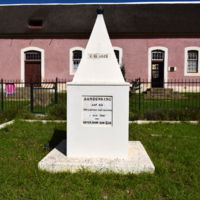
Elim Heritage Centre
Elim Heritage Centre was opened in 2009 in the Moravian mission village of Elim. Situated in the former mission store, it relies on funding from a grant by SAN Parks which permits a modest salary for its sole member of staff. Elim was established in 1824 and, in common with other mission stations in the area, saw an influx of newly freed people following the end of the post-abolition apprenticeship period in 1838. The centenary of the ending of the apprenticeship period in 1938 was marked in Elim by a monument situated across the road from the Moravian Mission Church. A feasibility study for an Elim offshoot of UNESCO’s Cape leg of its Slave Route project in the late 1990s revealed that many Elim residents were unaware about their slave heritage. Although the feasibility study did not amount to a longer-term UNESCO project, the undertaking did encourage interest in slave history in Elim. The 1938 monument was rededicated in 2004, and the Heritage Centre’s foundation can be traced to the feasibility study. As well as featuring as a community repository including donated trade and home objects, photographs, and clothing, its collections include a series of display panels created by the Slave Route feasibility study.
The Heritage Centre’s displays are modest and consist mainly of photographs pinned to display boards. There is little on slavery itself, although one primarily photographic panel shows a clear pride in the 1938 memorial and the way in which it has functioned as a form of remembering slavery over time in Elim. Reference is made to 1 December Emancipation Day as a way of reconnecting with ancestors. Another display details the genealogical origins of Elim, giving the names of early settlers among whom formerly enslaved people are clearly evident. The Slave Route display panels are not on open display. Indeed, it is the behind the scenes work of the curator where the Heritage Centre’s connections with slavery become more apparent. It holds substantial church records, and the curator assists with genealogical enquiries from around the world, including from people researching their slave ancestry.

Swellendam Drostdy Museum
Swellendam Drostdy Museum is one of 28 museums affiliated with the Western Cape Provincial Government's Museum Service. The museum is located in the former court complex in Swellendam, built in 1747 when Swellendam was situated on the frontier of the Dutch Cape of Good Hope. It was founded in 1939 and its displays are somewhat dated and offer a Eurocentric interpretation of the past. The collective heritage of Swellendam is represented through a magistrate's chamber, court room, and a number of domestic settings where the landdrost and his family would have relaxed between the important duties of enforcing European jurisdiction. A safe, the only original item from the building not destroyed in an 1865 fire, occupies a prominent place as a tangible link to this past.
A display opened in one of the barn outbuildings in 2006 seeking to imagine what this outbuilding may have been like two hundred years previously when it may have functioned as slave quarters. The Drostdy Museum's display illuminates a possible surviving link, doing this through a number of straw sleeping mats, food props, and carts. A series of interpretation panels explain slavery at the Cape and give the names and roles of several people enslaved/indentured at Swellendam Drostdy. In light of this, it is somewhat problematic that the museum created controversy in 2015 when it leased one of its buildings to an upmarket eatery. This was given the name 'The Whipping Post' by its owner in reference to the whipping post which formerly stood adjacent to the jail. Activists and local politicians highlighted the links between slavery and the original whipping post, and the outlet was ultimately renamed 'The Trading Post'.
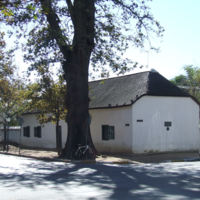
Stellenbosch Village Museum
Stellenbosch Village Museum is one of 28 museums affiliated with the Western Cape Provincial Government’s Museum Service. The Village Museum consists of four period houses dating from the early eighteenth century to the Victorian era. It opened during the 1970s as part of what was then a larger complex of museums in Stellenbosch. The museum was partially redeveloped by Museum Service staff in 2015, with new exhibition panels and an interactive historical timeline installed in the foyer area. Focus is given to the historical origins of Stellenbosch with attention given to a diverse range of historical actors, from the enslaved to Khoi people. This is an important part of moving historical interpretation at the Village Museum away from the whites-only affair established in the apartheid years. Artefacts uncovered during excavations of the period houses and their outbuildings are displayed, though these lack contextual information in places.
Slavery is not referred to in great detail in the exhibition panels, however it does feature on the interactive timeline. Both the abolition of the slave trade in 1807 and abolition of slavery in 1834 are referenced. Efforts are made to posit the Bletterman family – original owners of the Village Museum’s late eighteenth century property - as slave owners. Particular attention is given to the case study of the enslaved woman Manisa who was owned by Stellenbosch resident Johanna Barbara van Biljon. This focus comes from the unusual level of surviving material which enabled a reconstruction of Manisa’s life, including separation from her family through public auction. There is even a full body portrait of Manisa, taken from a Cape Argus article published upon emancipation. Problematically, one of the outbuildings of Bletterman House which potentially functioned as slave quarters has been rented out by the museum and presently houses a number of eateries. No connection is made between references to the outbuildings as slave quarters in the historical timeline and their present use.
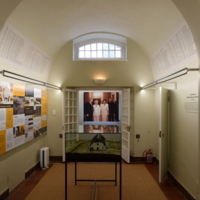
Vergelegen
Vergelegen is a wine estate, founded in 1700 and presently owned by Anglo-American subsidy AmFarms. As with the majority of South African wine farms of such a vintage, its early labour force rested on enslavement. Historical interpretation on the estate can be traced to an archaeological dig conducted by a team of academics from the University of Cape Town between 1990 and 1992. At a time of burgeoning scholarly enquiry into Cape slavery, this work excavated the former slave lodge on Vergelgen with the explicit intention of unearthing items which might hint towards the existence of slave culture. A number of personal items including coins and buttons were discovered, whilst the most significant find was of the skeletal remains of an enslaved woman who was affectionately named ‘Flora’ by estate staff.
The results of the archaeological work were displayed in the estate’s foyer together with contextual information. This made Vergelegen probably the first location in South Africa to mount a detailed exhibition relating to Cape slavery. The existence of the archaeological objects can be considered particularly significant, given that few tangible links with Cape slavery exist in museum collections. A second exhibition focussing on Vergelegen’s historical owners was developed several years later in the former manor house, and both exhibitions were subsequently amalgamated prior to being refreshed in 2016.
Presently, the names of people known to have been enslaved on Vergelegen are listed on the wall/ceiling of the first gallery, whilst the origins of enslaved people and their role on the estate are made clear. The objects unearthed during the early 1990s are displayed as tangible links with a past described by text. Additional historical context focuses on wine farming and the early Cape economy, historical estate owners, and notable visitors to Vergelegen.